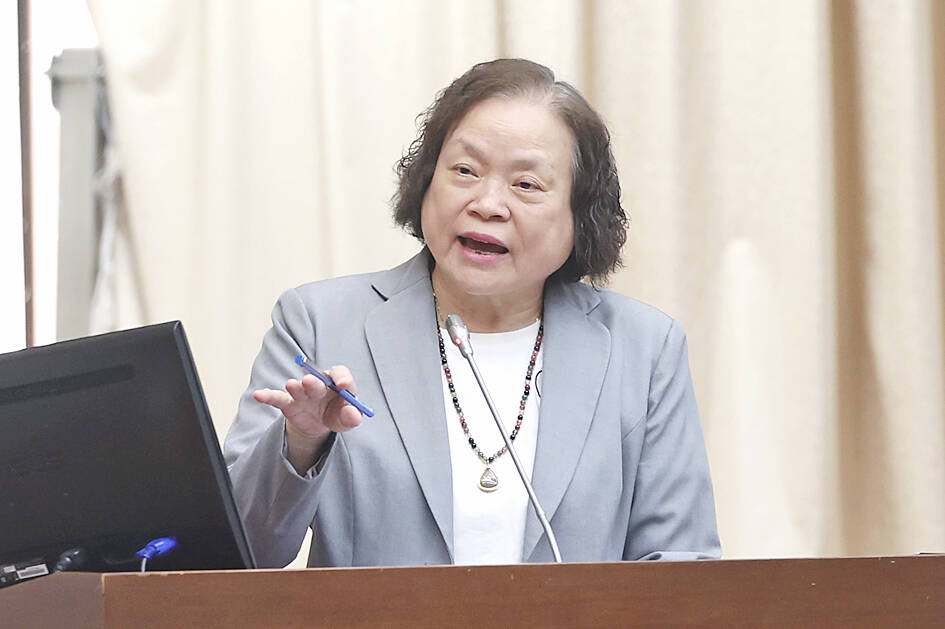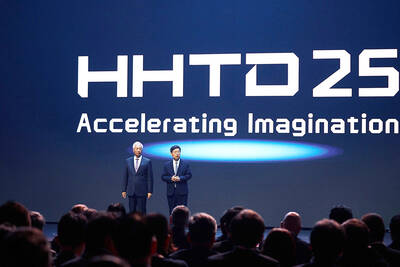Taiwan yesterday cut its GDP growth forecast for this year to 3.1 percent, marginally lower than the previous estimate of 3.14 percent, weighed by expectations of a sharp slowdown in the second half due to global trade tensions and tariff pressure from the US.
The Directorate-General of Budget, Accounting and Statistics (DGBAS) said economic momentum is likely concentrated in the first half with a growth of 5.35 percent, but might weaken to 1 percent for the remainder of the year.
DGBAS Minister Chen Shu-tzu (陳淑姿) attributed the expected slowdown to attenuated global demand and the impact of US protectionist trade policies under US President Donald Trump.

Photo: CNA
Taiwan’s traditional high season for exports — typically driven by strong holiday demand for consumer electronics in Western markets — might be muted by trade uncertainty and tariff volatility, Chen said.
The IMF last month downgraded its global trade growth forecast for this year to 1.7 percent, from 3.2 percent in January, citing declining momentum across key economies, she said.
Despite the global headwinds, Taiwan’s tech sector remains robust so far, as electronic components and information communications technology products make up nearly 70 percent of outbound shipments, benefiting from keen artificial intelligence (AI) infrastructure demand, the statistics agency said.
Major cloud service providers and national governments are aggressively expanding computing power, while supply chain bottlenecks have eased, paving the way for continued export growth, Statistics Department head Tsai Yu-tai (蔡鈺泰) said.
That explained why Taiwan’s economy grew 5.48 percent in the first quarter from a year earlier, slightly above last month’s estimate of 5.37 percent and significantly stronger than February’s forecast of 3.46 percent.
However, the bulk of exports would likely take place in the first half of the year, with a volume of US$275.7 billion, up 22.55 percent from a year earlier, largely on the back of front-loading to dodge US tariffs, the DGBAS said.
Exports are expected to contract 3.2 percent to US$242 billion in the second half, mitigating full-year growth to 8.99 percent at US$517.7 billion, Tsai said, adding that tariffs and foreign exchange rates carry a heavy weight in deciding market directions.
Sweeping tariffs on global trading partners would also negatively impact Taiwanese goods made in third countries and shipped to other destinations, Tsai said.
Private investment would be another bright spot, helped by the AI boom that would lead semiconductor suppliers to expand advanced manufacturing and packaging capabilities, the DGBAS said.
However, a cooling real-estate market and persistent geopolitical risks have tethered overall investment interest.
The agency is now looking at investment growth of 5.77 percent, a downward revision of 0.41 percentage points from the previous prediction.
Consumer spending remains resilient, thanks to a stable labor market, rising wages and higher dividend payouts from listed companies, it said.
Nevertheless, mounting global economic uncertainty and financial market volatility are restraining confidence, it said.
Private consumption is forecast to grow 1.64 percent this year, down 0.48 percentage points from the earlier projection, the DGBAS said.
Against that backdrop, Taiwan’s consumer prices might rise 1.88 percent, indicating manageable price pressures despite external risks, it said.

Shiina Ito has had fewer Chinese customers at her Tokyo jewelry shop since Beijing issued a travel warning in the wake of a diplomatic spat, but she said she was not concerned. A souring of Tokyo-Beijing relations this month, following remarks by Japanese Prime Minister Sanae Takaichi about Taiwan, has fueled concerns about the impact on the ritzy boutiques, noodle joints and hotels where holidaymakers spend their cash. However, businesses in Tokyo largely shrugged off any anxiety. “Since there are fewer Chinese customers, it’s become a bit easier for Japanese shoppers to visit, so our sales haven’t really dropped,” Ito

The number of Taiwanese working in the US rose to a record high of 137,000 last year, driven largely by Taiwan Semiconductor Manufacturing Co’s (TSMC, 台積電) rapid overseas expansion, according to government data released yesterday. A total of 666,000 Taiwanese nationals were employed abroad last year, an increase of 45,000 from 2023 and the highest level since the COVID-19 pandemic, data from the Directorate-General of Budget, Accounting and Statistics (DGBAS) showed. Overseas employment had steadily increased between 2009 and 2019, peaking at 739,000, before plunging to 319,000 in 2021 amid US-China trade tensions, global supply chain shifts, reshoring by Taiwanese companies and

Taiwan Semiconductor Manufacturing Co (TSMC) Chairman C.C. Wei (魏哲家) and the company’s former chairman, Mark Liu (劉德音), both received the Robert N. Noyce Award -- the semiconductor industry’s highest honor -- in San Jose, California, on Thursday (local time). Speaking at the award event, Liu, who retired last year, expressed gratitude to his wife, his dissertation advisor at the University of California, Berkeley, his supervisors at AT&T Bell Laboratories -- where he worked on optical fiber communication systems before joining TSMC, TSMC partners, and industry colleagues. Liu said that working alongside TSMC

TECHNOLOGY DAY: The Taiwanese firm is also setting up a joint venture with Alphabet Inc on robots and plans to establish a firm in Japan to produce Model A EVs Manufacturing giant Hon Hai Precision Industry Co (鴻海精密) yesterday announced a collaboration with ChatGPT developer OpenAI to build next-generation artificial intelligence (AI) infrastructure and strengthen its local supply chain in the US to accelerate the deployment of advanced AI systems. Building such an infrastructure in the US is crucial for strengthening local supply chains and supporting the US in maintaining its leading position in the AI domain, Hon Hai said in a statement. Through the collaboration, OpenAI would share its insights into emerging hardware needs in the AI industry with Hon Hai to support the company’s design and development work, as well